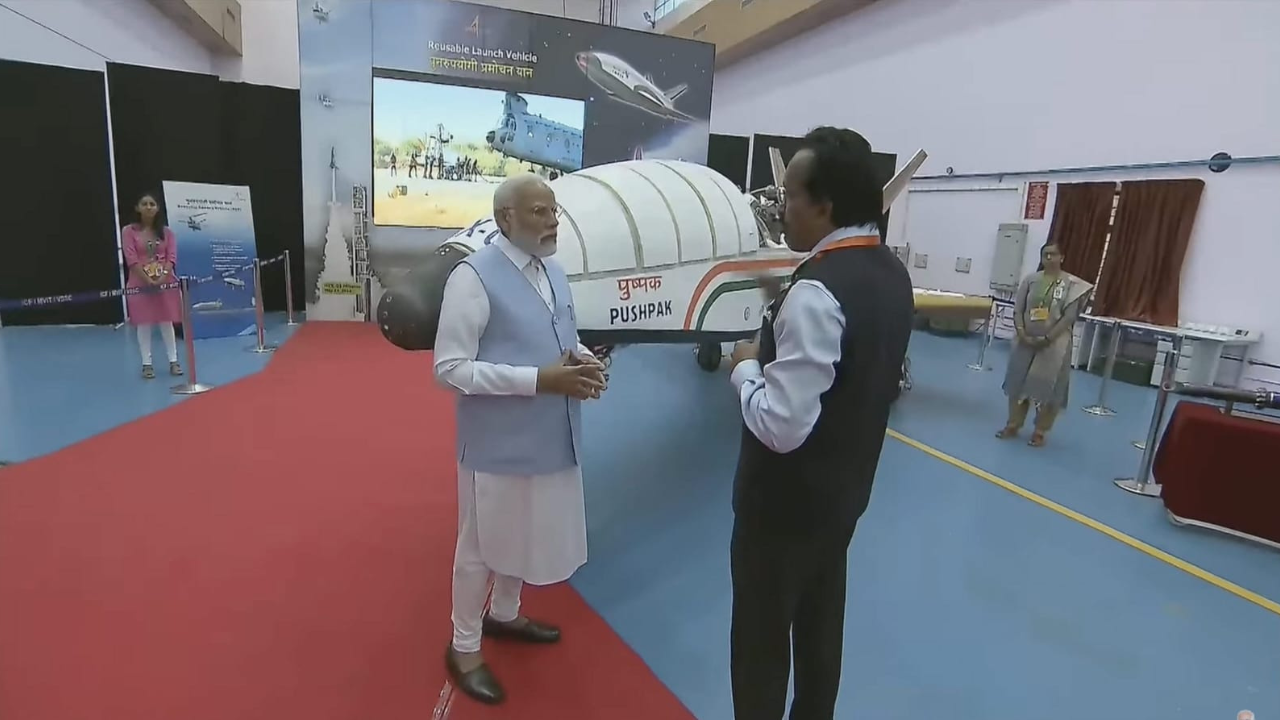BENGALURU: An important programme that will demonstrate one of the technologies needed to meet India’s ambitions of sustained human presence in space is scheduled for a key landing experiment (LEX) at the Aeronautical Test Range (ATR) in Challakere, Chitradurga, 220km from Bengaluru, Isro chairman S Somanath confirmed to TOI in an exclusive interview.
The experiment will be of a scaled down version of the Reusable Launch Vehicle (RLV), a desi version of the Space Shuttle, and the test could happen in the first half of the coming week.
“It could happen any day now. The vehicle has reached Chitradurga and it could happen next week. Last time, we’d done a nominal test where the dropping was aligned with the runway and the whole process of landing was in one plane. In the next test, we are going lateral, dropping it away from the runway and the RLV will need to take a detour and come and land on the runway,” Somanath said in the March 12 interview.
The nominal test Somanath refers to was carried out early on April 2, 2023 — the RLV autonomous landing mission or RLV-LEX at Challakere using a scaled down version of the RLV technology demonstrator (RLV—TD). The actual vehicle will be 1.6 times larger than the one used.
Stating that the altitude from which the RLV will be dropped and the speeds will be the same as last year’s test, Somanath said that in the future, the RLV will test other conditions like wind, different failure conditions and so on…
In the next test, the RLV will be carried to an altitude of about 4.5km by an Indian Air Force (IAF) helicopter and released for carrying out an autonomous landing on a runway. RLV is essentially a space plane with a low lift-to-drag ratio requiring an approach at high-glide angles that necessitates a landing at high velocities of 350kmph.
Isro will be using the Chinook helicopter which will carry the RLV as an underslung load and fly to a height of 4.5km. Once the predetermined parameters are attained, based on the RLV’s mission management computer command, the RLV will be released mid-air.
Release conditions will include multiple parameters covering position, velocity,altitude and body rates, etc and release was autonomous. Given that there will be a lateral drift in dropping this time, the RLV’s approach and landing manoeuvres using the integrated navigation, guidance & control system will differ from the April 2023 autonomous landing.
The experiment will be of a scaled down version of the Reusable Launch Vehicle (RLV), a desi version of the Space Shuttle, and the test could happen in the first half of the coming week.
“It could happen any day now. The vehicle has reached Chitradurga and it could happen next week. Last time, we’d done a nominal test where the dropping was aligned with the runway and the whole process of landing was in one plane. In the next test, we are going lateral, dropping it away from the runway and the RLV will need to take a detour and come and land on the runway,” Somanath said in the March 12 interview.
The nominal test Somanath refers to was carried out early on April 2, 2023 — the RLV autonomous landing mission or RLV-LEX at Challakere using a scaled down version of the RLV technology demonstrator (RLV—TD). The actual vehicle will be 1.6 times larger than the one used.
Stating that the altitude from which the RLV will be dropped and the speeds will be the same as last year’s test, Somanath said that in the future, the RLV will test other conditions like wind, different failure conditions and so on…
In the next test, the RLV will be carried to an altitude of about 4.5km by an Indian Air Force (IAF) helicopter and released for carrying out an autonomous landing on a runway. RLV is essentially a space plane with a low lift-to-drag ratio requiring an approach at high-glide angles that necessitates a landing at high velocities of 350kmph.
Isro will be using the Chinook helicopter which will carry the RLV as an underslung load and fly to a height of 4.5km. Once the predetermined parameters are attained, based on the RLV’s mission management computer command, the RLV will be released mid-air.
Release conditions will include multiple parameters covering position, velocity,altitude and body rates, etc and release was autonomous. Given that there will be a lateral drift in dropping this time, the RLV’s approach and landing manoeuvres using the integrated navigation, guidance & control system will differ from the April 2023 autonomous landing.
Denial of responsibility! Swift Telecast is an automatic aggregator of the all world’s media. In each content, the hyperlink to the primary source is specified. All trademarks belong to their rightful owners, all materials to their authors. If you are the owner of the content and do not want us to publish your materials, please contact us by email – swifttelecast.com. The content will be deleted within 24 hours.


